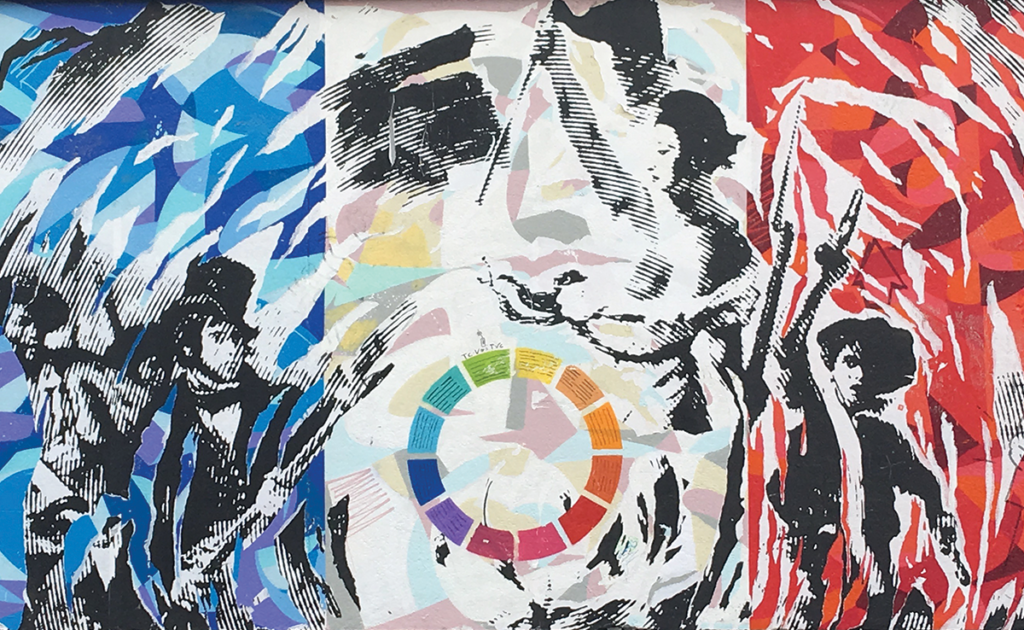Dr. Heidi Kraus remembers precisely the moment it happened.
“When I was a young kid, I traveled to France,” recalls Kraus. “I remember walking into the Grand Gallery in the Louvre, where all the large-format paintings are. There was one painting in particular, ‘The Coronation of Napoleon’ by Jacques-Louis David. It’s basically life-sized and it depicts the moment when Napoleon crowns Josephine. I remember thinking, ‘This is the most amazing thing ever.’ I’m 12 years old, looking at these figures and they are just huge. It was like I was transported into that time, brought into that painting.”
“From that point on, I became fascinated with everything France.”
The passion she discovered as a child led Kraus to her professional focus on French art of the Napoleonic era. But in 2015, a new project captured her imagination — one that bridges centuries and is rooted in a devastating act of terrorism.
Kraus has lived and studied in the City of Lights, and lectures to Hope students in the Louvre under Jacques-Louis David’s majestic painting during May Term sessions. So she responded even more viscerally than many Americans to the appalling news in late 2015 of coordinated terrorist attacks in and around Paris, which killed 130 people. “I know this city. I know where these things happened,” she relates.
“My only connection to the events there was via social media. Having this really intimate relationship with that city and not being able to do anything, having to experience it all from afar, was gut-wrenching.”
Weeks later, reading online accounts of the bombings, shootings and deadly siege at a rock concert inside the Bataclan theater, she came across an article and photo that stopped her in her tracks. Parents whose children’s school is on a block where one of the attacks occurred had organized a neighborhood collective to reclaim that street through art.
“Two cafés along that street were attack sites, and you can imagine parents having to walk their children past them every day on their way to school,” says Kraus. “What was created there was called the ‘Wall of Love,’ and one of the images on the wall was by an artist named Jo Di Bona, who clearly had a sense of art history. He looked to an extremely famous image from 1830, ‘Liberty Leading the People’ by Eugène Delacroix, and reinterpreted it on the wall.” The Delacroix painting includes a female figure known as Marianne, who personifies liberty and the French Republic. “That image is super-laden with meaning in a 19th-century context, but what does it mean now, post-attacks?”
As that rare art historian also trained in studio art, Kraus was fascinated by this re-creation of the old to represent the new on the streets of Paris.
Encouraged by her Hope May Term teaching partner, historian Dr. Lauren Janes, Kraus began a new, ambitious project: to document street art and public spaces inspired by the terror attacks. Kraus and a student collaborator — art history and psychology double major Julia Hines ’18 — began digitally mapping the locations in proximity to Paris landmarks, and charting and assessing changes to the artwork and surrounding areas over time.
“The visualization of memory is really what this project has been all about,” she says. “And when you say ‘French’ today, you’re not just talking about white men anymore. What about the huge Muslim population? Does liberty extend to them as well? And how does that materialize in art?”
Kraus recalls the first time she visited the “Wall of Love” just months after the attacks. Within seconds she was approached by locals demanding to know who she was. “Terrorist tourism exists, and I was extremely cautious when I first approached that wall,” says Kraus. “Once I explained I was a professor conducting research, one of them led Lauren and me on a three-hour street art tour.”
When Kraus returned with Hines in May 2017, the wall had been painted over. “Julia and I immediately go, ‘Oh, no!’” Kraus recalls. “Then it came to me: Of course it’s gone. That’s the nature of street art. It’s ephemeral. It doesn’t last. But given the fact that this was almost a memorial, I was a little surprised. With this idea of France being so old and having so much historical memory, what does that mean?”
The same process played out at the Place de la République, a public square featuring a famous statue of Marianne. Following the attacks, Kraus found it transformed into a lieux de mémoires — “place of memory.” “What I was stunned by was that the monument was completely covered, head to toe, with graffiti, memorials, candles,” says Kraus. “It was a place where the people could go to grieve, and to create work where they could express themselves. It stayed up for about seven or eight months, then a month or so after I left the city they quickly took it down. They cleaned it all, and put a lot of the memorials and ephemera into a museum. It was almost as if the city was saying, ‘OK, you’ve had your time. You’ve mourned. Now it’s time to move on.’”
Once digital mapping of the street art is complete, Hines will catalog and annotate the many photographs that she and Kraus have taken. They’ll be uploaded to a website that’s part of the Mellon Grand Challenges Initiative funded by the Andrew W. Mellon Foundation.
Meanwhile, Kraus has a related project underway. She has been asked by a major academic press to write a book on why looking at art is important in the 21st century.
She recently co-authored A Short History of the Ancient World with Purdue University professor of classics Nicholas Rauh — a four-year endeavor — for the University of Toronto Press, which released the book in December 2017.
